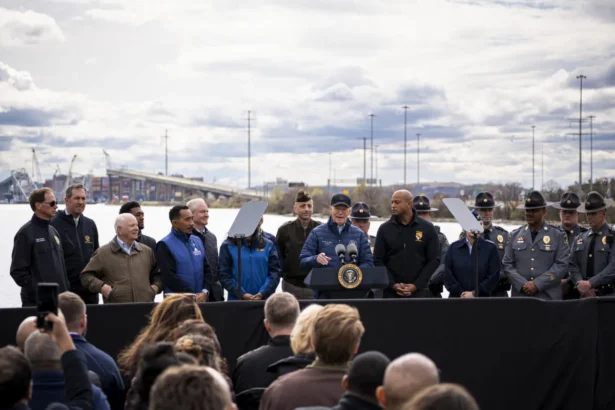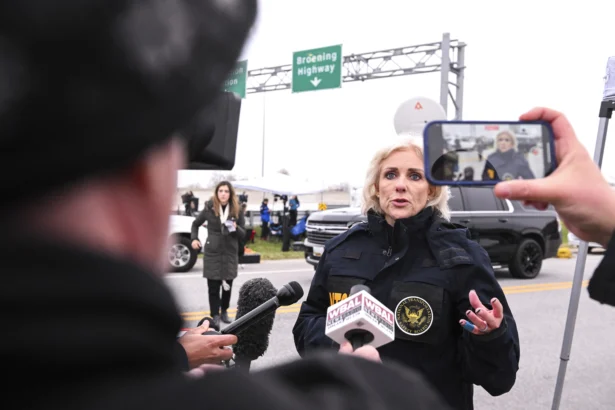There are two recovery efforts in Baltimore Harbor: the urgent one below the destroyed Francis Scott Key Bridge and the methodical “pay-and-chase” one unfolding in Congress and, eventually, in courtrooms around the world.
Although progress is being made in clearing 50,000 tons of bridge debris from a massive containership pinned 30 feet deep into riverbed mud since March 26, compensating American taxpayers footing the bill—at least $1.2 billion, likely more than $2 billion—could take decades.
“We can pretty much with certainty guarantee this will not be 100 percent federally funded, eventually, because we will recoup all the insurance payments,” Federal Highway Administration (FHWA) Administrator Shailen Bhatt testified on May 15 before the House Transportation and Infrastructure Committee.
The problem with that guarantee is that “we’ll all be dead by the time we get the money,” Rep. Rick Larsen (D-Wash.) said during a two-hour hearing on the federal response and investigation into the 95,000-ton Singapore-flagged Dali’s March 26 allision that killed six people, destroyed the 1.6-mile Key bridge, and shut down the Port of Baltimore for weeks.
But first things first: The Dali remains pinioned to the bridge’s fractured pylons. More than 180 of its 4,700 containers have been removed. On May 13, controlled explosions removed the truss that had fallen onto it.
More than 350 workers from 53 federal, state, and local agencies and at least 550 contractors are engaged in the extraction involving 10 Coast Guard boats, 36 barges, 27 tugboats, 22 floating cranes, and 10 excavators, Coast Guard Deputy Commandant for Operations Vice Adm. Peter Gautier testified.
The Coast Guard has spent “about $20 million,” he said, cautioning that the meter is running on the tally.
Alternate channels of depths to 11, 14, and 20 feet were dredged days after the crash, with a 48-foot deep channel opened on April 25, testified Maj. Gen. Butch Graham, Army Corps of Engineers deputy commanding general for civil and emergency operations.
As of May 13, he said, 365 commercial ships have transited the channels, including all ships trapped in port by the Dali’s crash.
“The Corps is on track to complete the removal of [the fallen bridge] by mid-May and to restore two-way traffic [under the bridge] by the end of May,” Maj. Gen. Graham said.
The Army Corps has spent $37 million, he said, noting that about $33 million in committed revenues to projects elsewhere have been “reappropriated” to Baltimore Harbor.
All this is a drop in the bucket.

Bipartisan, to a Degree
President Joe Biden pledged on March 26 that the federal government “will pay for the entire cost of reconstructing that bridge,” which some say could, over years of litigation typical in maritime liability claims, approach $4 billion over the five to seven years it will take to rebuild Key Bridge, an I-695 span used by 12 million vehicles per year and a vital Northeast Corridor link for 45 years.
On March 28, Maryland applied for funding from the FHWA’s Emergency Relief Program and was issued $60 million—roughly 5 percent of the initial $1.2 billion recovery estimate.
Under the emergency program, the federal government reimburses states at 100 percent for the first 70 days after approving an emergency application. After that, states get reimbursed at 80 percent to 90 percent.
On April 11, Maryland’s congressional delegation introduced Senate Bill 4114, the “Baltimore Bridge Response Invests and Delivers Global Economic Relief Act,” or the “Baltimore BRIDGE Act,” which would pay the entire cost of the reconstruction of the Key Bridge, including 5 percent upfront, anywhere now from $170 million to $190 million.
The bill would eliminate federal cost-share requirements for the emergency disaster-damaged highways and bridges fund, which has about $870 million and “$3.7 billion in unmet needs,” according to Mr. Bhatt.
Nevertheless, “the benefit the 100 percent [cost] share brings is it just removes an element of uncertainty” in ensuring that recovery moves as quickly as possible, he said.
Mr. Bhatt said certainty ensures that state, local government, and metropolitan planning organization infrastructure projects remain in place and on pace.
“You’re planning these multi-year, multibillion-dollar construction programs not knowing whether or not that $170 million is going to be there. It does impact things. [Eliminating] an element of uncertainty, that would be helpful,” he said.
Rep. Rick Crawford (R-Ark.) said FHWA approved Maryland’s request to designate the Key Bridge part of the interstate system from its Maryland State Route 695 designation to qualify for 90 percent reimbursement as I-695 rather than 80 percent as a state highway.
That classification gives Maryland “a delta of $170 to $190 million” in savings at current estimates and then another “delta of 10 percent” in savings as recovery moves along, Mr. Crawford said, questioning the need for such “certainty” so early in the effort.
Besides, he said, the fund isn’t doling out money.
“Some say we need 100 percent federal funding so we can get the rebuilding done quickly, but that’s not how the program works. It’s a reimbursement program,” Mr. Crawford said.
He said it needs “to be clear that nothing is going to move faster if this is 100 percent federal funded versus 90 percent or any other percentage.”
“The administration is asking … Congress to join it in demonstrating a commitment to aid in recovery efforts,” Mr. Bhatt said. “There are no Democratic roads or Republican bridges—transportation truly unites us.”
As does the “pay-and-chase” search for the liable. According to National Transportation Safety Board (NTSB) Chair Jennifer Homendy, a key step has been taken in determining what happened and who pays what.

Investigation’s First Discoveries
A May 14 NTSB preliminary report “shows the Dali experienced four total power outages” over a two-day span dockside in Baltimore before losing power and steering on the Patapsco River and knocking down the bridge, she said.
Two power failures in port were related to routine maintenance, and two “were unexpected tripping of circuit breakers on the ‘accident voyage,’” which began early on March 26, according to Ms. Homendy.
“A blackout occurred when a crew member mistakenly closed an engine damper while he was working on the exhaust system in port. This effectively blocked the engine’s exhaust gases … causing the engine to stall [as the ship pulled into the river],” she said.
Power was briefly restored, but insufficient fuel pressure caused the ship to lose propulsion, prompting a breaker to trip, plunging the ship into powerless darkness again, according to Ms. Homendy.
“While recovering from the second blackout, the crew switched to a different transformer instead of breakers from those that had been in use for several months,” she said.
“Switching breakers is not unusual, but it may have affected operations the very next day on the ‘accident voyage.’ So, the configuration of breakers remains under investigation.”
There are also questions regarding the low-sulfur oil fuel the Dali used since March 21, Ms. Homendy said, but tests have not identified issues with samples from the ship.
“This is a complex investigation. Our investigators have been on scene consistently since this accident. In fact, they are on board the vessel as I testify today,” she said. “It is unprecedented to be there that long.”
Every day the bridge isn’t there imposes costs, Transportation and Infrastructure Committee Chair Rep. Sam Graves (R-Mo.) said, noting that traffic accidents on area road networks have increased by 29 percent and alternate routes are adding two to four hours to some locals’ daily drive times.
That traffic means that trucks are delayed in reaching their destinations, commuters are late getting to their jobs or home to their families, and there is more air pollution and wasted fuel.
Mr. Graves said the work needs to get done before any promises are made that American taxpayers must keep.
“While the president’s request has been received and it’s under consideration, Congress still has roughly six months to act before any cost-share changes might occur,” he said. “It’s important we have a very firm estimate before we take any further action.”
From The Epoch Times
